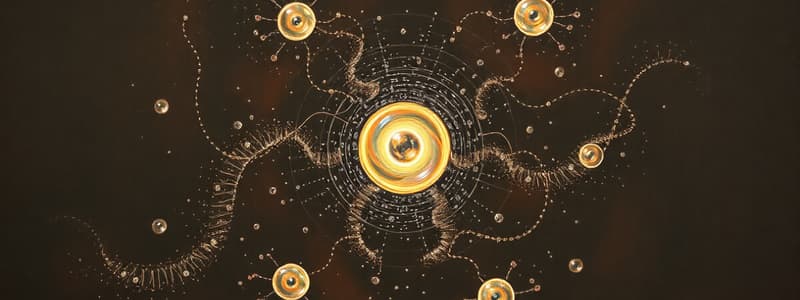Podcast
Questions and Answers
What is the primary characteristic of a homogeneous mixture?
What is the primary characteristic of a homogeneous mixture?
- It contains at least three different substances.
- It can be separated by physical means.
- The parts are not evenly distributed.
- The parts are evenly distributed. (correct)
Which of the following substances is correctly categorized as a compound?
Which of the following substances is correctly categorized as a compound?
- Sand
- Salt
- Gold
- Water (correct)
What happens during a chemical change?
What happens during a chemical change?
- The temperature of the substance remains constant.
- The appearance of a substance changes.
- A new substance with new properties is formed. (correct)
- The state of matter remains unchanged.
In which phase of matter do molecules move the fastest?
In which phase of matter do molecules move the fastest?
What is the density of water?
What is the density of water?
Which phase change describes the transition from a solid to a liquid?
Which phase change describes the transition from a solid to a liquid?
What defines an object that has a density of less than 1 g/cc?
What defines an object that has a density of less than 1 g/cc?
Which process is considered a physical change?
Which process is considered a physical change?
What charge does a neutron carry?
What charge does a neutron carry?
Which group of elements is known as the Noble Gases?
Which group of elements is known as the Noble Gases?
How is the mass number of an atom determined?
How is the mass number of an atom determined?
What type of bonding involves the transfer of electrons?
What type of bonding involves the transfer of electrons?
Which of the following statements about metals is true?
Which of the following statements about metals is true?
Which element has an atomic number of 53?
Which element has an atomic number of 53?
What property do elements in the same group have in common?
What property do elements in the same group have in common?
What is the oxidation number of sodium (Na) when it forms a positive ion?
What is the oxidation number of sodium (Na) when it forms a positive ion?
Flashcards
Atom
Atom
The basic building block of matter.
Proton
Proton
Positively charged particle in the atom's nucleus.
Electron
Electron
Negatively charged particle orbiting the nucleus.
Atomic Number
Atomic Number
Signup and view all the flashcards
Ionic Bonding
Ionic Bonding
Signup and view all the flashcards
Covalent Bonding
Covalent Bonding
Signup and view all the flashcards
Period (Periodic Table)
Period (Periodic Table)
Signup and view all the flashcards
Family/Group (Periodic Table)
Family/Group (Periodic Table)
Signup and view all the flashcards
Homogenous Mixture
Homogenous Mixture
Signup and view all the flashcards
Heterogenous Mixture
Heterogenous Mixture
Signup and view all the flashcards
Physical Change
Physical Change
Signup and view all the flashcards
Chemical Change
Chemical Change
Signup and view all the flashcards
Solid
Solid
Signup and view all the flashcards
Liquid
Liquid
Signup and view all the flashcards
Density
Density
Signup and view all the flashcards
Density Triangle
Density Triangle
Signup and view all the flashcards
Study Notes
Atomic Structure and the Periodic Table
- Atoms are the building blocks of matter.
- Protons are positively charged particles located in the nucleus.
- Neutrons are neutrally charged particles located in the nucleus.
- Electrons are negatively charged particles located outside the nucleus in energy levels.
- Atomic number equals the number of protons in an atom.
- Mass number is the sum of protons and neutrons.
- An atomic number of 53 and a mass number of 127 identifies the element Iodine.
- Elements are arranged on the periodic table by increasing atomic number.
- Horizontal rows on the table are called periods.
- Vertical columns are called groups or families.
- Elements in the same group have similar properties due to similar valence electrons.
Types of Elements
- Metals are located on the left side of the periodic table.
- Metals are good conductors of heat and electricity.
- Characteristics of metals include luster, ductility, and malleability.
- Metalloids have properties of both metals and nonmetals, found along the "zig-zag" line.
- Nonmetals are found on the right side of the periodic table.
Bonding
- Chemical bonding is the combining of atoms of elements to form new substances.
- Ionic bonding involves a transfer of electrons between metals and nonmetals.
- Covalent bonding involves sharing electrons between nonmetals.
- Ions are charged atoms.
- Oxidation numbers represent the charge on an atom in a compound.
Mixtures and Pure Substances
- Substances can be pure elements or compounds or mixtures.
- Mixtures contain two or more substances combined physically, not chemically.
- Homogenous mixtures have evenly distributed parts.
- Heterogenous mixtures have unevenly distributed parts.
- Examples of mixtures (milk, raisin bran, iced tea).
- Examples of compounds (water, carbon dioxide, table salt).
- Examples of elements (Gold, Hydrogen).
Physical and Chemical Changes
- Physical changes affect appearance but not the substance's chemical composition.
- Chemical changes form new substances with different properties.
- Examples of physical changes (melting, boiling, phase changes).
- Examples of chemical changes (burning, rotting, rusting).
States of Matter
- Liquids have molecules that are spread out more than solids but less spread out than gases.
- Liquids have a definite volume but not a definite shape.
- Gases have molecules that are spread out widely, with no definite shape or volume.
- Solids have tightly packed molecules that vibrate slowly. Solids have a definite shape and volume.
- Density is the mass per unit volume of a material. Density does not change with the size of the material.
- Water has a density of 1 g/cc.
- Objects with a density less than water float. Objects with a higher density than water sink.
Studying That Suits You
Use AI to generate personalized quizzes and flashcards to suit your learning preferences.



